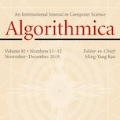For a fixed integer $k\ge 2$, a $k$-community structure in an undirected graph is a partition of its vertex set into $k$ sets called communities, each of size at least two, such that every vertex of the graph has proportionally at least as many neighbours in its own community as in any other community. In this paper, we give a necessary and sufficient condition for a forest on $n$ vertices to admit a $k$-community structure. Furthermore, we provide an $O(n^{2})$-time algorithm that computes such a $k$-community structure in a forest, if it exists. These results extend a result of [Bazgan et al., Structural and algorithmic properties of $2$-community structure, Algorithmica, 80(6):1890-1908, 2018]. We also show that if communities are allowed to have size one, then every forest with $n \geq k\geq 2$ vertices admits a $k$-community structure that can be found in time $O(n^{2})$. We then consider threshold graphs and show that every connected threshold graph admits a $2$-community structure if and only if it is not isomorphic to a star; also if such a $2$-community structure exists, we explain how to obtain it in linear time. We further describe two infinite families of disconnected threshold graphs, containing exactly one isolated vertex, that do not admit any $2$-community structure. Finally, we present a new infinite family of connected graphs that may contain an even or an odd number of vertices without $2$-community structures, even if communities are allowed to have size one.
翻译:暂无翻译



